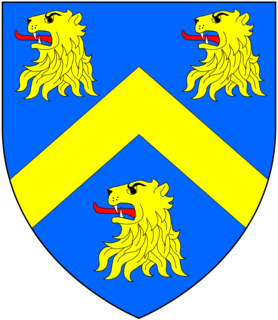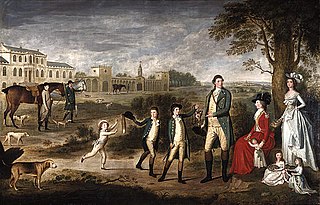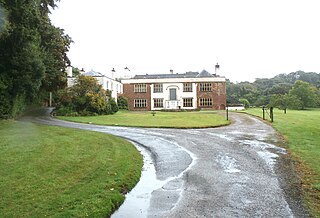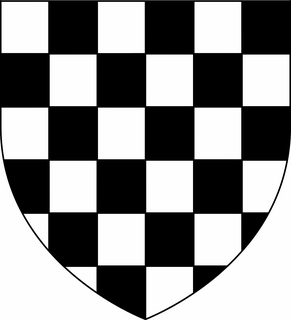
Earl of Egmont was a title in the Peerage of Ireland, created in 1733 for John Perceval, 1st Viscount Perceval. It became extinct with the death of the twelfth earl in 2011.

Earl of Rosslyn is a title in the Peerage of the United Kingdom. It was created in 1801 for Alexander Wedderburn, 1st Baron Loughborough, Lord Chancellor from 1793 to 1801, with special remainder to his nephew Sir James St Clair-Erskine, as Wedderburn had no surviving issue of his own. Wedderburn had already been created Baron Loughborough, of Loughborough in the County of Leicester, in the Peerage of Great Britain in 1780, with normal remainder to the heirs male of his body, and Baron Loughborough, of Loughborough in the County of Surrey, in the Peerage of Great Britain in 1795, with the same remainder as the earldom. The 1780 barony became extinct upon his death, but the 1795 barony and the earldom passed, by the special remainder, to his nephew, who thus became the second Earl of Rosslyn. The second Earl was a Lieutenant-General in the Army and also held political office as Lord Privy Seal and Lord President of the Council.

Earl of Egremont was a title in the Peerage of Great Britain. It was created in 1749, along with the subsidiary title Baron of Cockermouth, in Cumberland, for Algernon Seymour, 7th Duke of Somerset, with remainder to his nephews Sir Charles Wyndham, 4th Baronet, of Orchard Wyndham, and Percy Wyndham-O'Brien. The Duke had previously inherited the Percy estates, including the lands of Egremont in Cumberland, from his mother Lady Elizabeth Percy, daughter and heiress of Joceline Percy, 11th Earl of Northumberland. In 1750 Sir Charles Wyndham succeeded according to the special remainder as second Earl of Egremont on the death of his uncle. His younger brother Percy Wyndham-O'Brien was created Earl of Thomond in 1756.

There have been five baronetcies of the United Kingdom created for a person with the surname Erskine, two in the Baronetage of Nova Scotia, one in the Baronetage of Great Britain and two in the Baronetage of the United Kingdom. Two of the creations are extant as of 2010.

There have been two baronetcies created for persons with the surname Fisher, both in the Baronetage of England.
The office of High Sheriff of Somerset is an ancient shrievalty which has been in existence since the 11th century. Originally known as the "Sheriff of Somerset", the role was retitled on 1 April 1974, under the provisions of the Local Government Act 1972.

There have been three Wyndham Baronetcies, all created in the Baronetage of England. All were created for descendants of Sir John Wyndham (d.1573) of Orchard Wyndham in the parish of Watchet, Somerset, by his wife Elizabeth Sydenham, daughter and co-heiress of Sir John Sydenham of Orchard Sydenham. He was a grandson of Sir John Wyndham of Felbrigg, Norfolk, by his first wife Lady Margaret Howard, 4th daughter of John Howard, 1st Duke of Norfolk.

Orchard Wyndham is a historic manor near Williton in Somerset, centred on the synonymous grade I listed manor house of Orchard Wyndham that was situated historically in the parish of Watchet and about two miles south of the parish church of St Decuman's, Watchet. Parts of the manor house are medieval. It has been owned for more than 700 years by the prominent Wyndham family, who continue there as of 2015.

Combe Sydenham is an historic manor in Somerset, England. The 15th-century manor house, called Combe Sydenham House is in the parish of Stogumber, Somerset and is situated just within the boundary of Exmoor National Park. It is a Grade I listed building.

The Rudd Baronetcy, of Aberglassney in the County of Carmarthen, was a title in the Baronetage of England. It was created on 8 December 1628 for Richard Rudd. He was the son of Anthony Rudd, Bishop of St David's. The second baronet sat as member of parliament for Higham Ferrers and Carmarthenshire. The title became extinct on the death of the fourth Baronet in 1739.
Sir Ralph Sydenham was an English politician who sat in the House of Commons from 1641 to 1642. He supported the Royalist cause in the English Civil War.
Sir James Langham, 7th Baronet was an English politician who sat in the House of Commons from 1784 to 1790.

Sir John Sydenham, 2nd Baronet (1643–1696) was an English politician who sat in the House of Commons at various times between 1665 and 1679.

The Manor of Poltimore is a former manor in Devon, England. The manor house known as Poltimore House survives in its 18th-century remodelled form, but has been dilapidated for several decades. A charity named the "Poltimore House Trust" has been established for the purpose of its restoration. The manor was situated within the historic Wonford Hundred and was largely coterminous with the parish of Poltimore and contained the village of Poltimore, 4 miles (6.4 km) north-east of the historic centre of the City of Exeter. It should not be confused with the eponymous Devon estate of Poltimore in the parish of Farway, 16 miles (26 km) east of Exeter. Poltimore was the principal seat of the Bampfylde family from c. 1300 to 1920.

Richard Bampfield (1526–1594) of Poltimore and Bampfylde House in Exeter, both in Devon, was Sheriff of Devon in 1576. He began construction of the Tudor era Poltimore House in 1550, and completed the building of Bampfylde House, Exeter, along with The Great House, Bristol one of the finest Elizabethan townhouses in the West Country, in 1590. He is the ancestor of the Bampfylde Baronets and Barons Poltimore.

John Stourton of Preston Plucknett in Somerset was seven times MP for Somerset, in 1419, 1420, December 1421, 1423, 1426, 1429 and 1435.

Sir John St Barbe, 1st Baronet, of Ashington, Somerset and Broadlands, Hampshire, was Member of Parliament for Ilchester in 1681. He was created a baronet on 30 December 1662 at the age of 7.

Rev. Humphrey Sydenham, "Silver Tongue Sydenham", was a royalist divine, famous for his sermons.

Henry Northleigh (1643–1694) of Peamore in the parish of Exminster in Devon, was thrice MP for Okehampton in Devon.
Arthur Tremayne, of Sydenham, Devon, was a British Tory politician who sat in the House of Commons from 1727 to 1734.














